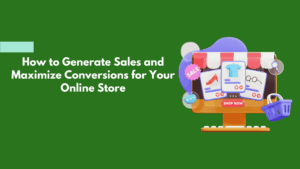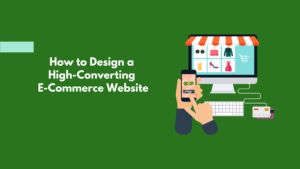E-commerce is booming, and businesses that establish a strong online presence are seeing massive success. Whether you’re launching a brand-new store or scaling an existing one, knowing how to build and grow an online business is key. But where do you start?
This guide will walk you through how to start a profitable e-commerce business from scratch. From choosing a niche to setting up a high-converting website for e-commerce business, we’ll cover every step in detail. Let’s dive in.
Table of Contents
Choosing the Right Niche
Your niche determines everything. Your target audience, marketing strategy, and how competitive your market will be. The right niche isn’t just about selling what you love; it’s about finding products that people are actively searching for and buying.
Start by researching market demand. Use tools like Google Trends, Amazon Best Sellers, and competitor analysis to see what’s trending. A great niche has both high demand and manageable competition.
Profitability is another key factor. Some products have high margins, while others require bulk sales to make money. Digital products, for example, have lower overhead costs than physical goods, which require inventory management and shipping.
Once you’ve identified a niche, validate it by talking to potential customers, running surveys, or even creating a small test store before committing fully.
Creating a Business Plan
Jumping into e-commerce without a plan is like setting sail without a map. A solid business plan keeps you focused and helps you make informed decisions.
Start with defining your business model. Are you dropshipping, manufacturing, or using a third-party supplier? Each approach has its benefits. Dropshipping is low-risk but competitive, while manufacturing gives you more control but requires investment.
Map out your revenue strategy. Will you price your products for premium positioning, or will you compete on affordability? Consider your cost structure, including product sourcing, e-commerce services website design, marketing, and shipping.
Set goals. How many sales do you aim for in your first three months? What’s your expected revenue in a year? Clear milestones help you measure success and pivot when needed.
Registering Your Business and Legal Considerations
Before you start selling, handle the legal side of your business. Choose a business structure that fits your needs. Sole proprietorships are easy to set up, but LLCs offer liability protection.
Secure your business name and domain early to protect your brand identity. If you’re serious about growth, consider trademarks and copyrights.
Also, look into necessary licenses and permits. Some products, like health supplements or electronics, require certifications before you can sell them legally. Understanding tax regulations, especially for international sales, will save you headaches later.
Sourcing Products and Managing Inventory
Now comes the big question—where will you get your products? If you’re selling physical goods, your sourcing strategy determines profit margins and customer satisfaction.
Dropshipping allows you to sell products without holding inventory, but supplier reliability is crucial. Research suppliers thoroughly, request samples, and check reviews before committing.
If you’re manufacturing or private labeling, quality control is everything. Work with reputable manufacturers, test your products, and ensure a smooth production process.
For inventory management, avoid overstocking or running out of popular items. Use tools like Shopify’s inventory tracker or third-party software to keep stock levels optimized.
Setting Up Your E-Commerce Website
Your website is your online storefront, and first impressions matter. A slow, confusing, or outdated website can kill sales instantly. That’s why investing in e-commerce services website design is a game-changer.
Choosing the best website builder for e-commerce business success depends on individual needs. For instance, Shopify and WooCommerce are great options, but the right choice depends on your budget and technical skills. At Texttot, we specialize in how to make a website for e-commerce services that’s optimized for sales, speed, and user experience.
Your website should be visually appealing, easy to navigate, and mobile-friendly. Customers should find products quickly, trust your checkout process, and complete purchases without frustration. High-quality product images, clear descriptions, and customer reviews all play a role in boosting conversions.
Secure payment gateways are essential. Offer multiple payment options like credit cards, PayPal, and even Buy Now, Pay Later options. Fast and transparent shipping options also increase customer trust.
Building Your Brand and Online Presence
E-commerce success isn’t just about selling products, it’s about building a brand people recognize and trust.
Start with your brand identity. Your name, logo, and color scheme should be consistent across your website for e-commerce business and social media platforms. A compelling brand story helps customers connect with you on a personal level.
Trust is everything. Display customer testimonials, social proof, and secure payment badges to reassure visitors. Transparency about return policies and shipping timelines also builds credibility.
Content marketing is a great way to establish authority. A blog filled with useful guides and tips can attract organic traffic and position you as an industry expert.
Driving Traffic to Your Store
A beautiful website won’t make money if no one sees it. Traffic is the fuel that keeps an e-commerce business website running.
SEO is one of the best long-term strategies. Optimize your website with relevant keywords so it ranks higher on Google. At Texttot, we help businesses with e-commerce services website design that attracts and converts visitors.
Paid advertising, like Google Ads and Facebook Ads, is great for instant traffic. Social media platforms like Instagram and TikTok also offer organic and paid options to drive traffic.
Email marketing is another powerful tool. Building an email list allows you to send promotions, updates, and personalized offers directly to your audience, increasing repeat sales.
Scaling Your E-Commerce Business
Once you’ve established your online store, it’s time to scale.
Automation can streamline your operations. Use AI chatbots, email automation, and inventory management tools to improve efficiency.
Expanding your product range can attract new customers and increase revenue. Analyze customer data to identify trends and introduce complementary products.
International expansion is another growth strategy. If your local market is saturated, consider selling in new regions. Ensure your website for e-commerce business is optimized for different currencies and languages.
Finally, customer retention is key. Acquiring a new customer costs more than retaining an existing one. Offer loyalty programs, personalized recommendations, and excellent customer service to keep buyers coming back.
Final Thoughts on How to Start a Profitable E-Commerce Business
Starting an online store is exciting, but success requires strategy, persistence, and the right tools. From choosing a niche to setting up an optimized website for e-commerce business, every step plays a role in profitability.
At Texttot, we specialize in how to make a website for e-commerce services that’s built for conversions. If you’re serious about growing your e-commerce business, let’s help you create a website that stands out in a crowded market.
Ready to launch your online store? Contact Texttot today for expert e-commerce services website design and strategy!


